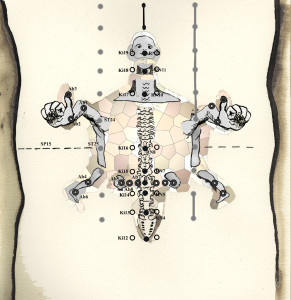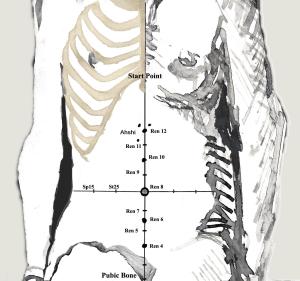Abdominal Acupuncture in a Turtleshell!
Abdominal acupuncture (AA) is one of the newest and most exciting forms of acupuncture to evolve from China. It was developed by Prof. Bo ZhiYun and it is becoming very popular because of its powerful results and its gentle nature (needle sensation), it treats all acute and chronic pain and many zang fu conditions.
It uses standard and new abdominal acupuncture points (Ab) known as the Abdominal Meridian System (AMS). The points used are contained within the area from Ren 12 Zhongwan to Ren 4 Guanyuan on the vertical line and to Sp 15 Daheng on the horizontal line.
Fig 1 An illustration of the AA Turtle hologram.
AA Theory in a TurtleShell
Abdominal acupuncture (Fu Zhen) theory utilises the energetic importance of the abdomen from a number of perspectives.
- Shenque Ren 8 is the epicentre from which all (Pre & post natal) meridian systems of the body originate. It is known as the Shenque system or AMS (Abdominal Meridian System) as proposed by Prof Bo.
- The proximity of the Zang Fu organs allows access directly or indirectly through the AMS.
- The fact that all the regular and extra ordinary meridians pass through the abdomen directly or through their Biao Li (internal / external organ) relationships. Therefore the Ren treats the Du mai and Kid affects the Urinary Bladder Channel. Allowing access to back Shu & front Mu points.
- The abdomen is regarded as our second brain due to the huge amount of neurons it contains and it is responsible for the production of more than 80% of serotonin which has many functions including regulating mood, digestion and sleep.
The Depths of Abdominal Acupuncture;
- Heaven / superficial level, treats head, torso, upper and lower limbs. It is represented by a map of the Turtle / Tortoise (see Fig 1). Needling depth is usually 0.1-0.5cun.
- Humanity / middle layer connects the internal and external. Based on the Jing Luo theory and regulates the meridians. Needling depth is usually 0.5-1.0cun.
- Earth / Deep level treats the Zang fu organs and is represented by the Ba Qua / 8 trigrams. Needling depth is usually 1.0-1.5cun.
Therapeutic effect is thus dependent on the location and depth of the needles.
Painful conditions are particularly good to treat as one can gauge the results instantaneously. Slight adjustments of the needle depth or location can have a profound effect on the final result. Palpation of the abdomen to locate ahshi points is paramount and with sensitivity practitioners will feel anomalies relating to the area of pain and by needling these points and breaking down local adhesions the pain is resolved. Below are some cases that I have treated in my clinic.
A total Headcase
John had suffered a severe brain injury in a freak accident. His injuries left him in excruitiating pain 24/7 from
- The left temple to the right temple.
- Fengchi GB20 on the right to Taiyang (extra) on the left.
I needled Ren 12, 10, 6 and 4 (bringing the qi home). I then palpated points above Ren 12 where I found small knots (Ahshi points). I needled these points quite superficially (0.1-0.4 cun) and then checked with John how his temple pain was; it had reduced to a very comfortable score of 2 (from 10). I palpated between Ren 11 & Ren 12 to find more ahshi points relating to the pain from GB20 – Taiyang, once again following superficial needling the pain completely disappeared within seconds (see fig 2). Even opiates had not given such pain relief.
Fig 2. An illustration of the prescription used to treat a Total Headcase.
Piles of pain
Jill complained of severe pain due to haemorrhoids which were making movement very uncomfortable for her. I asked her to put a score of 10 on her pain and discomfort and proceeded to treat her with abdominal acupuncture. I used the prescription of “bringing qi home” to move the qi to the kidney and supplement Spleen qi. To further supplement Spleen Qi , I used Ab 1 on the left and also added needles at kid 17 to enhance the effect of the needle at Ren 10 and qipang (extra point along the kidney meridian) to enhance the effect of Ren 6. I needled kidney 13 bilaterally to improve the effect of Ren 4 in strengthening the kidneys and also because of the anatomical location of Ren 4 being level with the L-4 / L-5 vertebrae. I then used an ahshi point just below Ren 4 and the pain and discomfort eased almost immediately. Following the treatment Jill felt a lot more comfortable and movement was easier. Jill reported on the next visit that the haemorrhoids were completely gone the following day.
I have developed and refined a system of AA that works for me which is based on my own clinical experience and the system that was taught to me by Dr. Yan Han in Nanjing. Through my research I have found different interpretations of AA as it continues to evolve. I encourage all my students to be flexible and to trust their intuition as to the exact location of anatomical areas with abdominal acupuncture. As with any form of acupuncture there are many ways of achieving good results and with a solid grounding and understanding of what prescriptions work for common conditions you can start to explore new techniques that will work for you and your clients. If you are interested in finding out more about Centreforce Abdominal Acupuncture courses please contact me at [email protected]
By Dave Shipsey (B.Sc. Hon’s), Grad Dip, C. Ac, A.Ac, Dip. Tuina, Dip. Buteyko Breathing M.A.F.P.A. M.B.B.A.
Please note that all illustrations are the property of Dave Shipsey and should not be reproduced without permission.



